fuel TOYOTA PRIUS PLUG-IN 2013 Owners Manual
[x] Cancel search | Manufacturer: TOYOTA, Model Year: 2013, Model line: PRIUS PLUG-IN, Model: TOYOTA PRIUS PLUG-IN 2013Pages: 704, PDF Size: 19.59 MB
Page 28 of 704
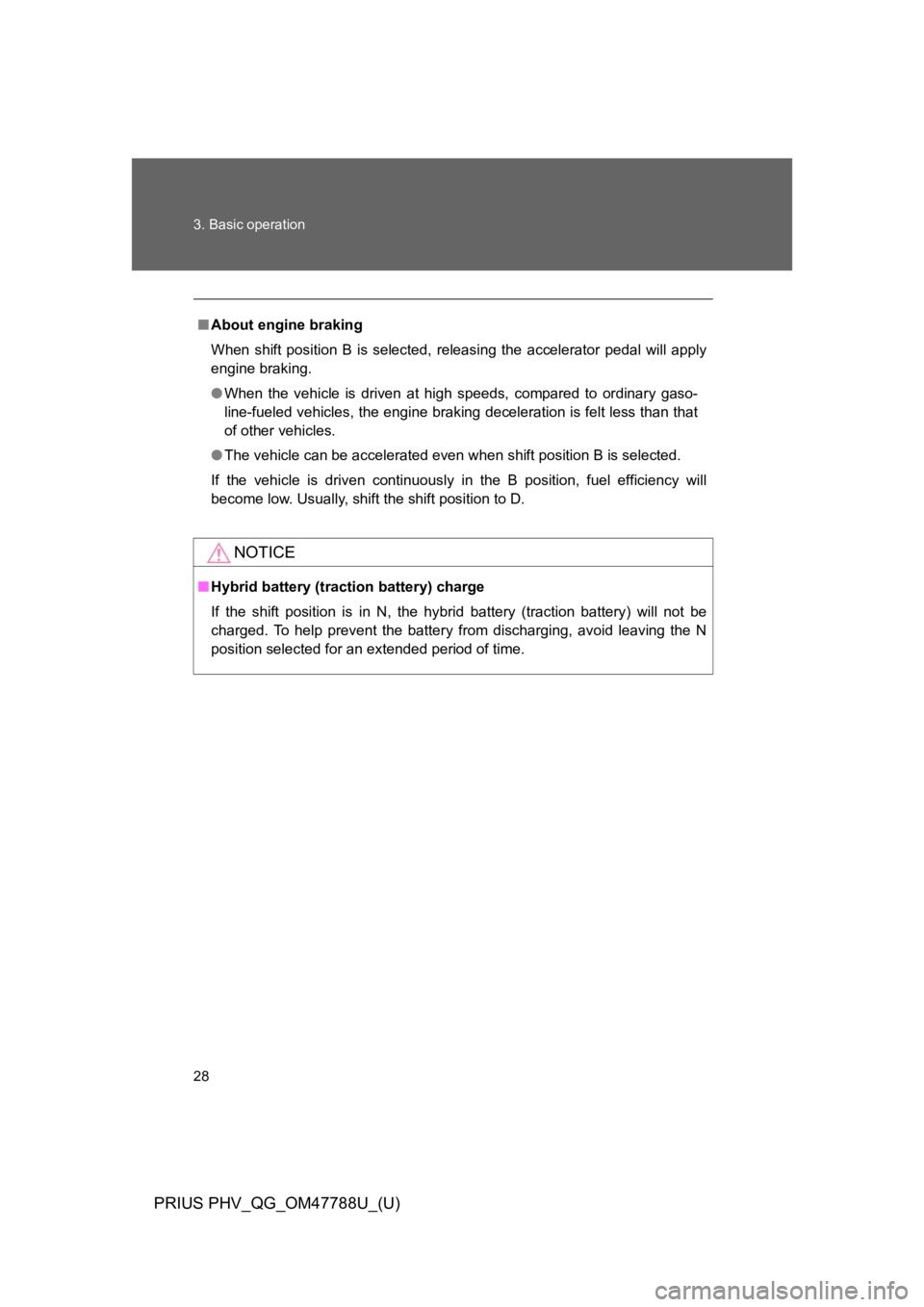
28
3. Basic operation
PRIUS PHV_QG_OM47788U_(U)
■About engine braking
When shift position B is selected, releasing the accelerator pedal will apply
engine braking.
●When the vehicle is driven at high speeds, compared to ordinary gaso-
line-fueled vehicles, the engine braking deceleration is felt less than that
of other vehicles.
●The vehicle can be accelerated even when shift position B is selected.
If the vehicle is driven continuously in the B position, fuel efficiency will
become low. Usually, shift the shift position to D.
NOTICE
■Hybrid battery (traction battery) charge
If the shift position is in N, the hybrid battery (traction battery) will not be
charged. To help prevent the battery from discharging, avoid leaving the N
position selected for an extended period of time.
Page 37 of 704
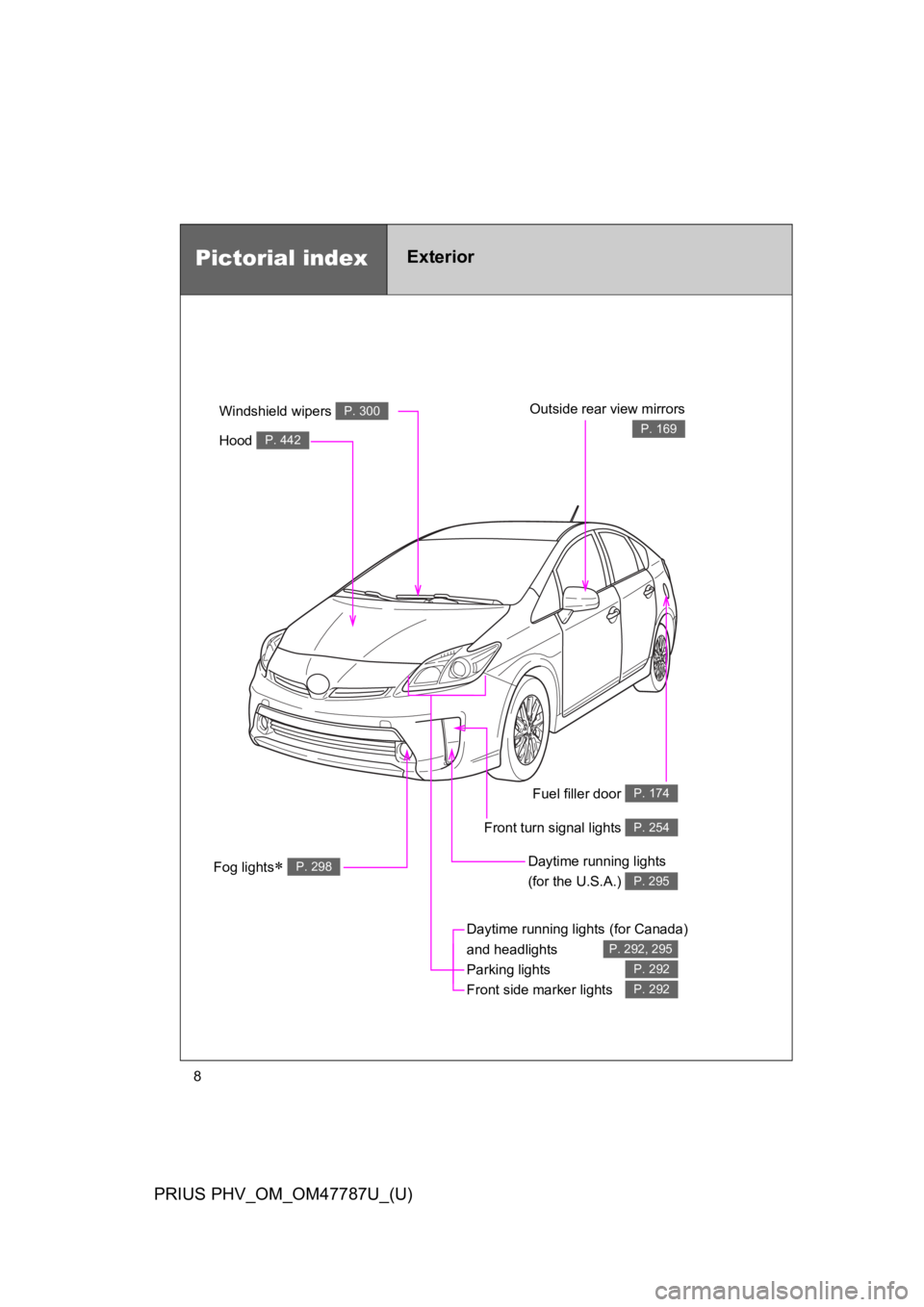
8
PRIUS PHV_OM_OM47787U_(U)
Fuel filler door P. 174
Pictorial indexExterior
Fog lights∗ P. 298
Daytime running lights (for Canada)
and headlights
Parking lights
Front side marker lights
P. 292, 295
P. 292
P. 292
Hood P. 442
Windshield wipers P. 300Outside rear view mirrors
P. 169
Front turn signal lights P. 254
Daytime running lights
(for the U.S.A.) P. 295
Page 45 of 704
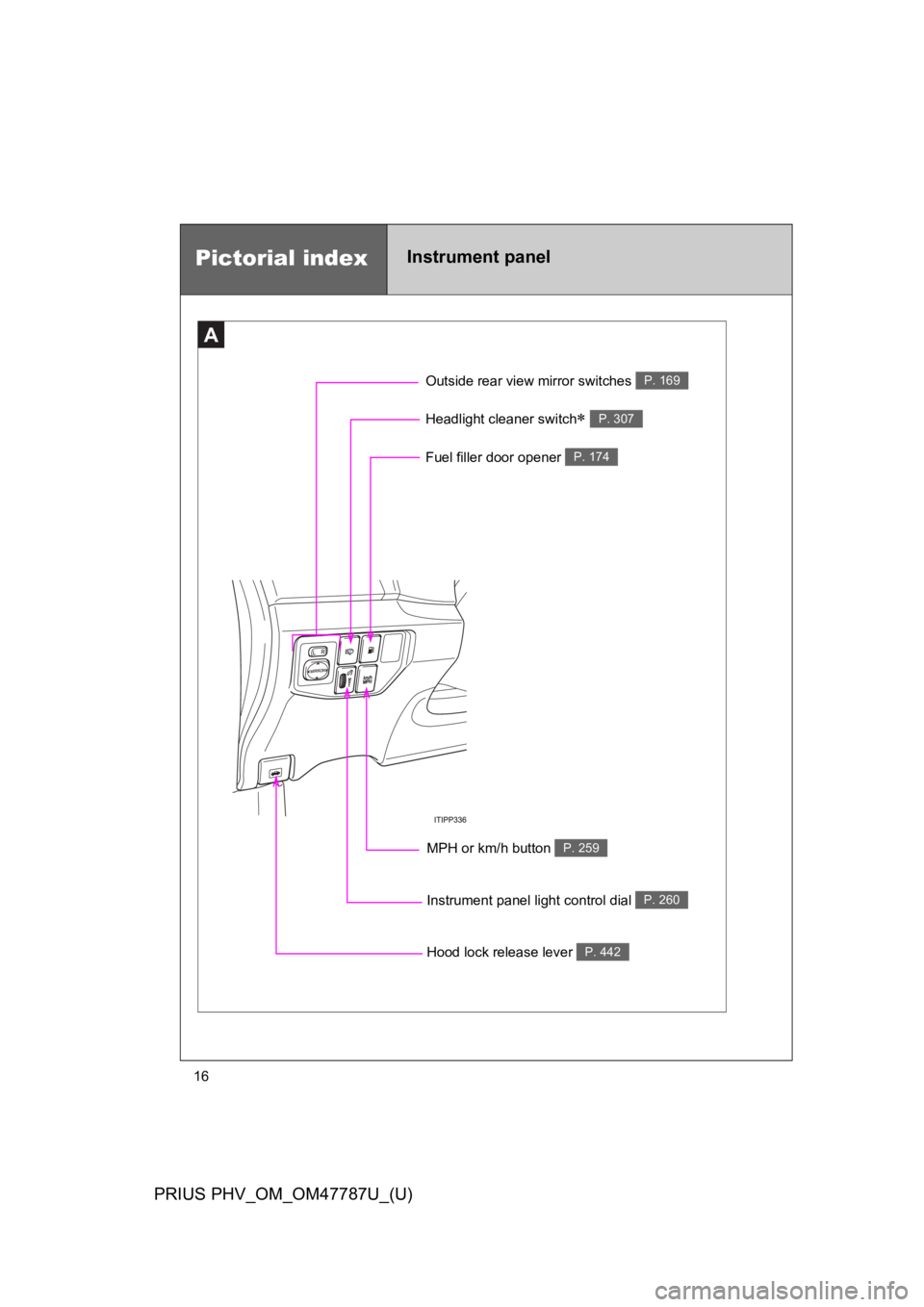
16
PRIUS PHV_OM_OM47787U_(U)
A
Instrument panel light control dial P. 260
Headlight cleaner switch∗ P. 307
Hood lock release lever P. 442
Outside rear view mirror switches P. 169
Pictorial indexInstrument panel
Fuel filler door opener P. 174
MPH or km/h button P. 259
Page 51 of 704

22
PRIUS PHV_OM_OM47787U_(U)
For your information
Main Owner’s Manual
Please note that this manual applies to all models and explains all equip-
ment, including options. Therefore, you may find some explanations for
equipment not installed on your vehicle.
All specifications provided in this manual are current at the time of printing.
However, because of the Toyota policy of continual product improvement, we
reserve the right to make changes at any time without notice.
Depending on specifications, the vehicle shown in the illustrations may differ
from your vehicle in terms of color and equipment.
Noise from under vehicle after turning off the hybrid system
Approximately five hours after the hybrid system is turned off, you may hear
sound coming from under the vehicle for several minutes. This is the sound
of a fuel evaporation leakage check and, it does not indicate a malfunction.
Accessories, spare parts and modification of your Toyota
A wide variety of non-genuine spare parts and accessories for Toyota vehi-
cles are currently available in the market. You should know that Toyota does
not warrant these products and is not responsible for their performance,
repair, or replacement, or for any damage they may cause to, or adverse
effect they may have on, your Toyota vehicle.
This vehicle should not be modified with non-genuine Toyota products. Mod-
ification with non-genuine Toyota products could affect its performance,
safety or durability, and may even violate governmental regulations. In addi-
tion, damage or performance problems resulting from the modification may
not be covered under warranty.
Page 52 of 704

23
PRIUS PHV_OM_OM47787U_(U)
Installation of a mobile two-way radio system
The installation of a mobile two-way radio system in your vehicle could affect
electronic systems such as:
●Multiport fuel injection system/sequential multiport fuel injection system
●Cruise control system
●Anti-lock brake system
●SRS airbag system
●Seat belt pretensioner system
Be sure to check with your Toyota dealer for precautionary measures or spe-
cial instructions regarding installation.
High voltage parts and cables on the hybrid vehicles emit approximately the
same amount of electromagnetic waves as the conventional gasoline pow-
ered vehicles or home electronic appliances despite of their electromagnetic
shielding.
Unwanted noise may occur in the reception of the mobile two-way radio.
Page 61 of 704
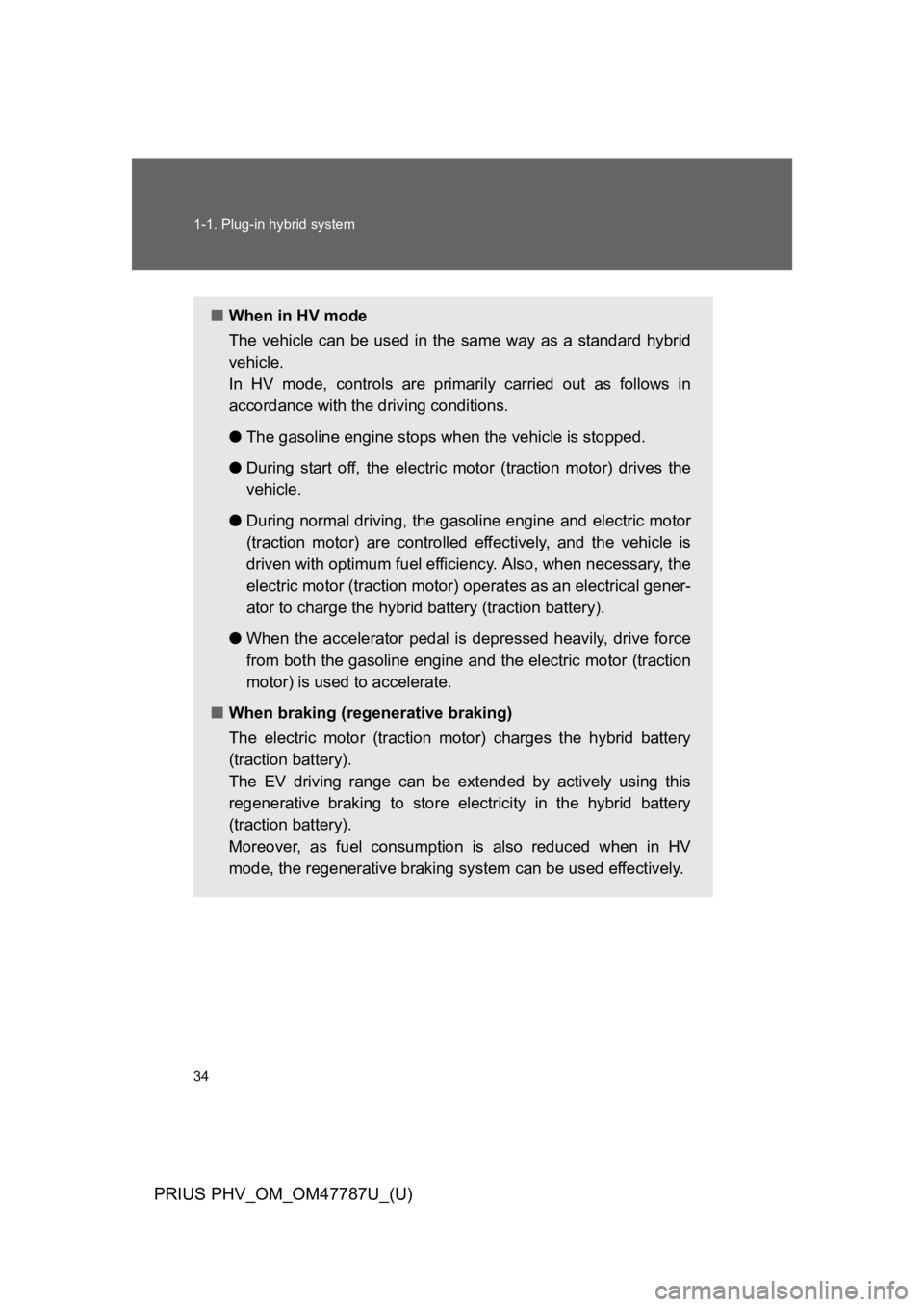
34
1-1. Plug-in hybrid system
PRIUS PHV_OM_OM47787U_(U)
■When in HV mode
The vehicle can be used in the same way as a standard hybrid
vehicle.
In HV mode, controls are primarily carried out as follows in
accordance with the driving conditions.
●The gasoline engine stops when the vehicle is stopped.
●During start off, the electric motor (traction motor) drives the
vehicle.
●During normal driving, the gasoline engine and electric motor
(traction motor) are controlled effectively, and the vehicle is
driven with optimum fuel efficiency. A l s o , w h e n n e c e s s a r y, t h e
electric motor (traction motor) operates as an electrical gener-
ator to charge the hybrid battery (traction battery).
●When the accelerator pedal is depressed heavily, drive force
from both the gasoline engine and the electric motor (traction
motor) is used to accelerate.
■When braking (regenerative braking)
The electric motor (traction motor) charges the hybrid battery
(traction battery).
The EV driving range can be extended by actively using this
regenerative braking to store electricity in the hybrid battery
(traction battery).
Moreover, as fuel consumption is also reduced when in HV
mode, the regenerative braking system can be used effectively.
Page 67 of 704
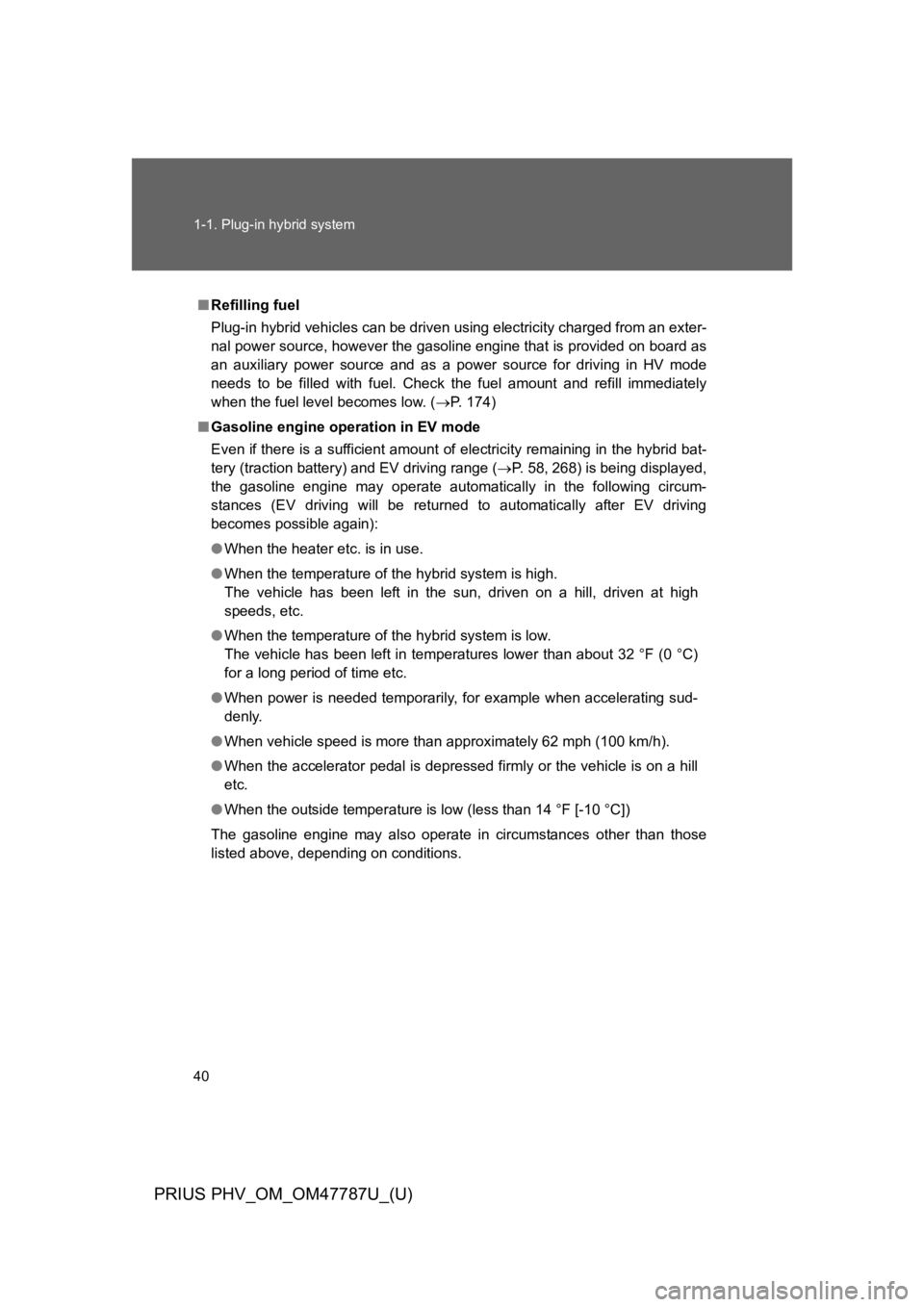
40
1-1. Plug-in hybrid system
PRIUS PHV_OM_OM47787U_(U)
■Refilling fuel
Plug-in hybrid vehicles can be driven using electricity charged from an exter-
nal power source, however the gasoline engine that is provided on board as
an auxiliary power source and as a power source for driving in HV mode
needs to be filled with fuel. Check the fuel amount and refill immediately
when the fuel level becomes low. (→P. 1 7 4 )
■Gasoline engine operation in EV mode
Even if there is a sufficient amount of electricity remaining in the hybrid bat-
tery (traction battery) and EV driving range (→P. 5 8 , 2 6 8 ) i s b e i n g d i s p l a y e d ,
the gasoline engine may operate automatically in the following circum-
stances (EV driving will be returned to automatically after EV driving
becomes possible again):
●When the heater etc. is in use.
●When the temperature of the hybrid system is high.
The vehicle has been left in the sun, driven on a hill, driven at high
speeds, etc.
●When the temperature of the hybrid system is low.
The vehicle has been left in temperatures lower than about 32 °F (0 °C)
for a long period of time etc.
●When power is needed temporarily, for example when accelerating sud-
denly.
●When vehicle speed is more than approximately 62 mph (100 km/h).
●When the accelerator pedal is depressed firmly or the vehicle is on a hill
etc.
●When the outside temperature is low (less than 14 °F [-10 °C])
The gasoline engine may also operate in circumstances other than those
listed above, depending on conditions.
Page 72 of 704
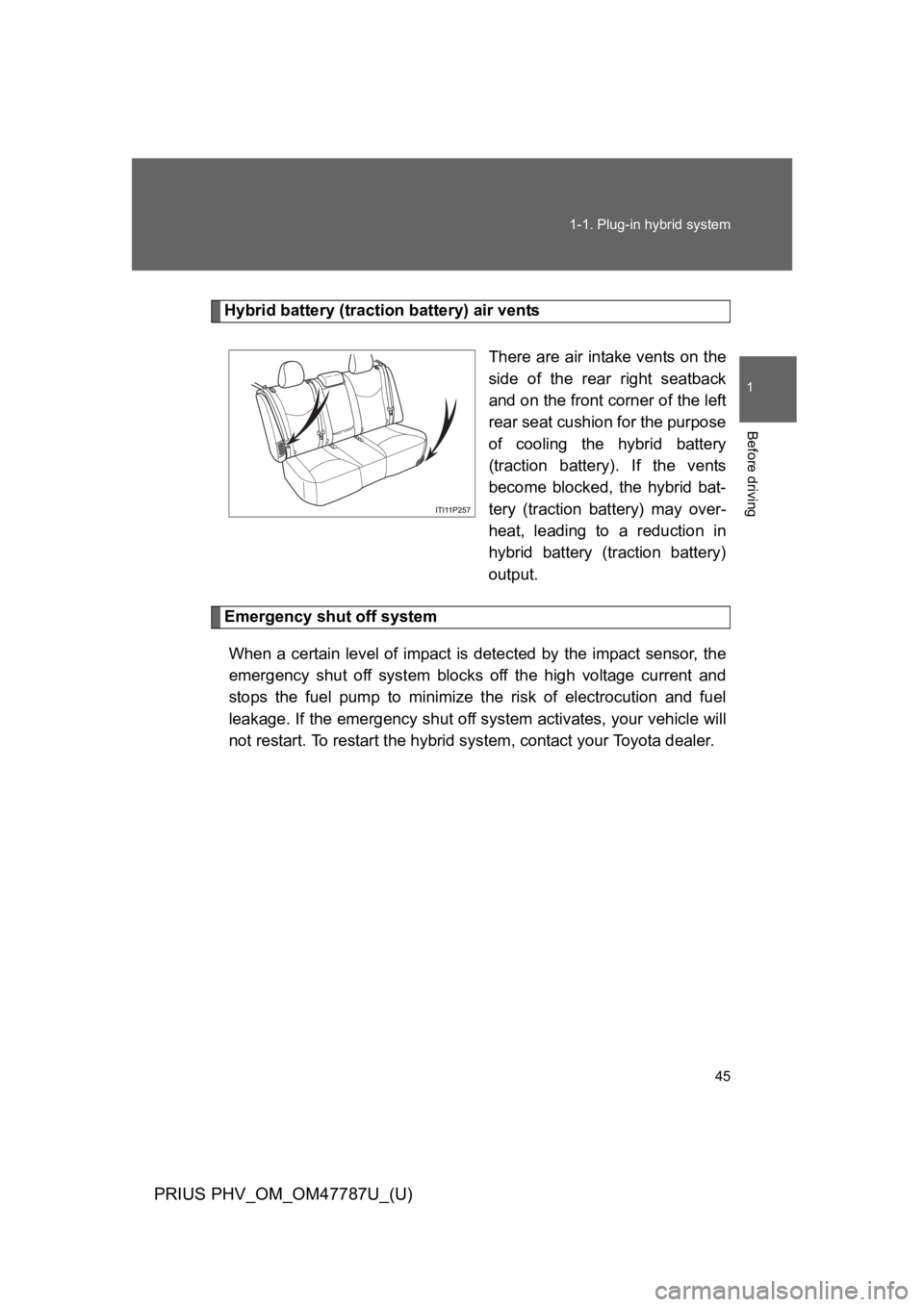
45
1-1. Plug-in hybrid system
1
Before driving
PRIUS PHV_OM_OM47787U_(U)
Hybrid battery (traction battery) air vents
There are air intake vents on the
side of the rear right seatback
and on the front corner of the left
rear seat cushion for the purpose
of cooling the hybrid battery
(traction battery). If the vents
become blocked, the hybrid bat-
tery (traction battery) may over-
heat, leading to a reduction in
hybrid battery (traction battery)
output.
Emergency shut off system
When a certain level of impact is detected by the impact sensor, the
emergency shut off system blocks off the high voltage current and
stops the fuel pump to minimize the risk of electrocution and fuel
leakage. If the emergency shut off system activates, your vehicle will
not restart. To restart the hybrid system, contact your Toyota dealer.
Page 73 of 704
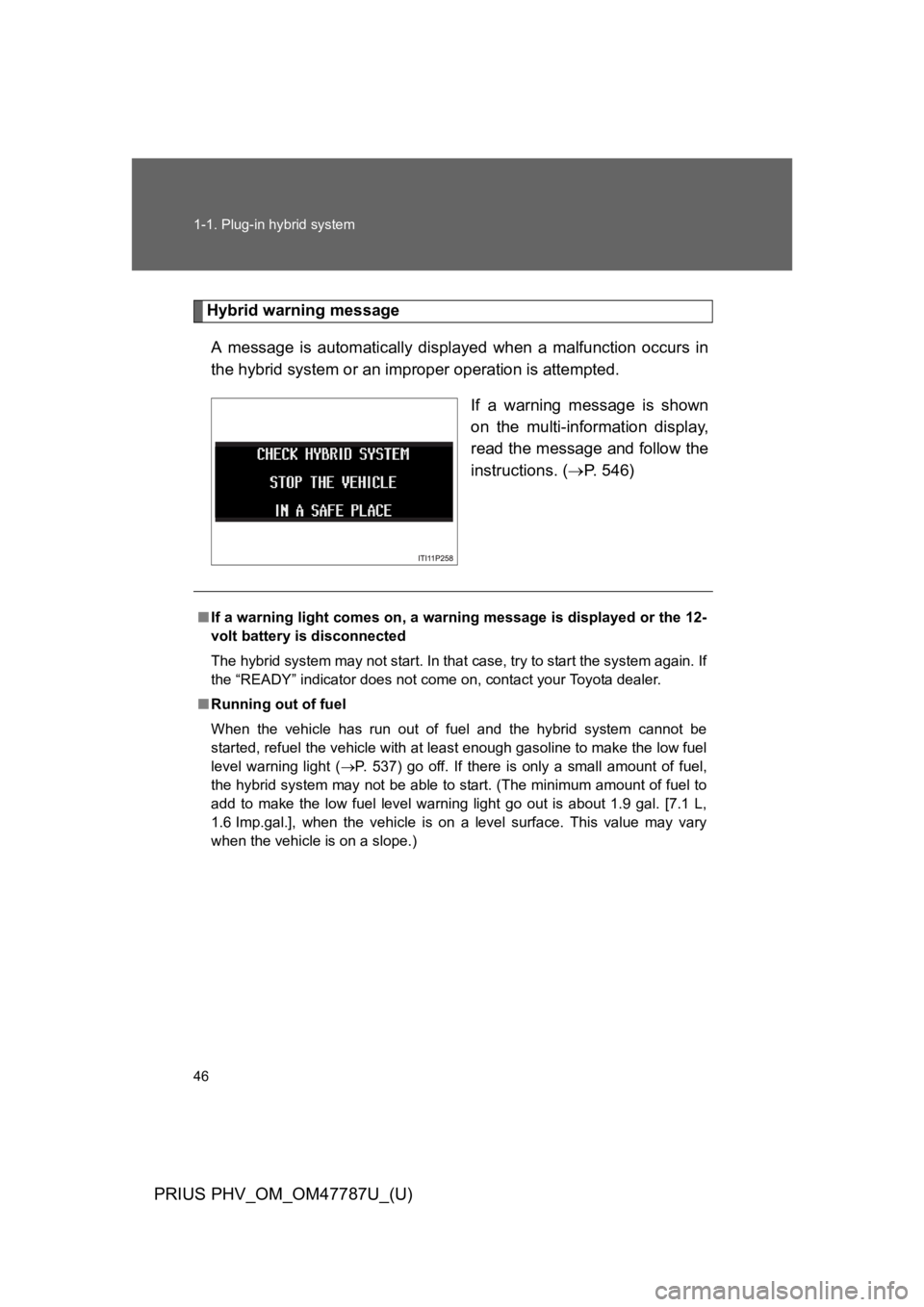
46
1-1. Plug-in hybrid system
PRIUS PHV_OM_OM47787U_(U)
Hybrid warning message
A message is automatically displayed when a malfunction occurs in
the hybrid system or an improper operation is attempted.
If a warning message is shown
on the multi-information display,
read the message and follow the
instructions. (→P. 5 4 6 )
■If a warning light comes on, a warning message is displayed or the 12-
volt battery is disconnected
The hybrid system may not start. In that case, try to start the system again. If
the “READY” indicator does not come on, contact your Toyota dealer.
■Running out of fuel
When the vehicle has run out of fuel and the hybrid system cannot be
started, refuel the vehicle with at least enough gasoline to make the low fuel
level warning light (→P. 5 3 7 ) g o o f f . I f t h e r e i s o n l y a s m a l l a m o u n t o f f u e l ,
the hybrid system may not be able to start. (The minimum amount of fuel to
add to make the low fuel level warning light go out is about 1.9 gal. [7.1 L,
1.6 Imp.gal.], when the vehicle is on a level surface. This value may vary
when the vehicle is on a slope.)
Page 77 of 704
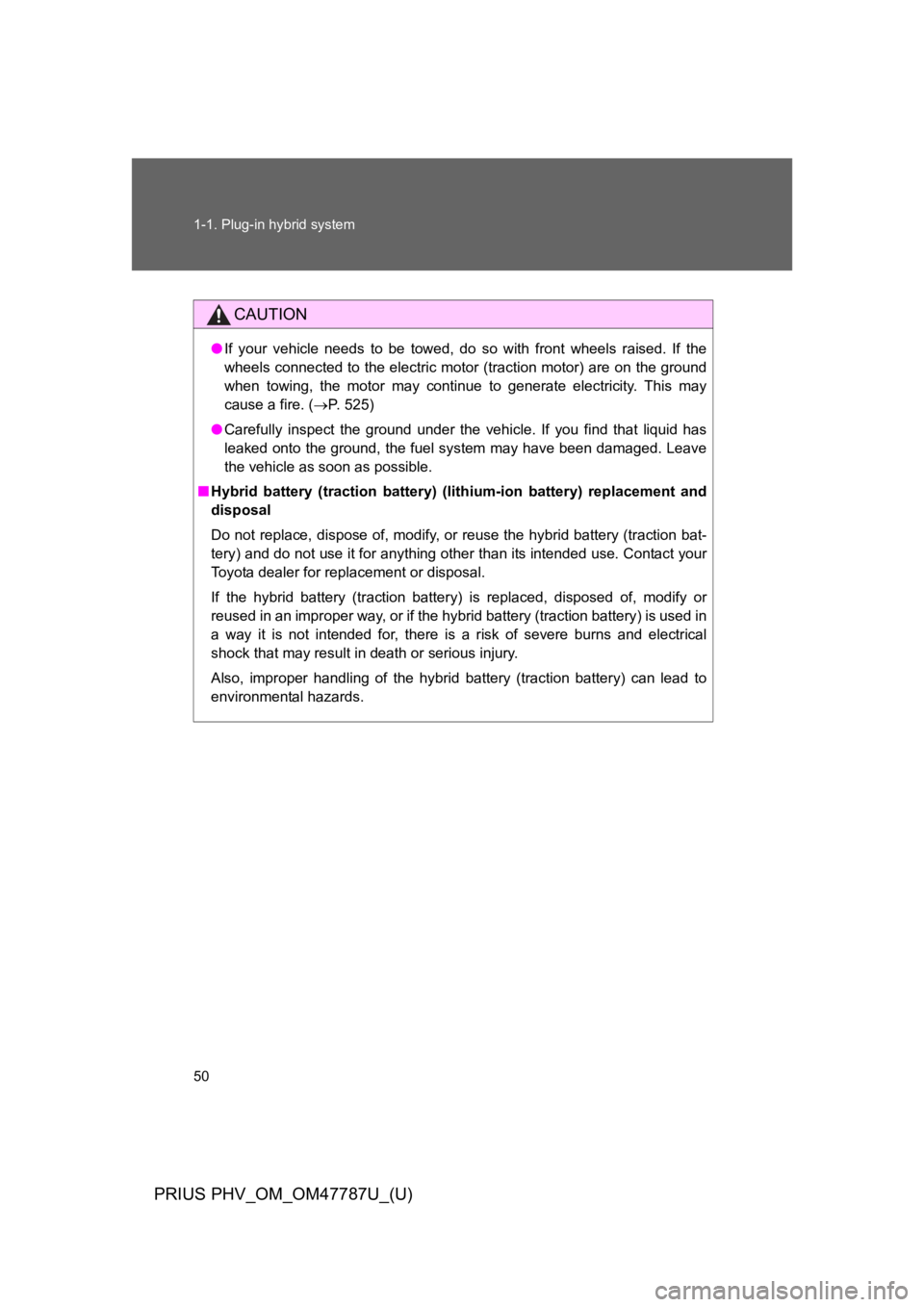
50
1-1. Plug-in hybrid system
PRIUS PHV_OM_OM47787U_(U)
CAUTION
●If your vehicle needs to be towed, do so with front wheels raised. If the
wheels connected to the electric motor (traction motor) are on the ground
when towing, the motor may continue to generate electricity. This may
cause a fire. (→P. 5 2 5 )
●Carefully inspect the ground under the vehicle. If you find that liquid has
leaked onto the ground, the fuel system may have been damaged. Leave
the vehicle as soon as possible.
■Hybrid battery (traction battery) (lithium-ion battery) replacement and
disposal
Do not replace, dispose of, modify, or reuse the hybrid battery (traction bat-
tery) and do not use it for anything other than its intended use. Contact your
To y o t a d e a l e r f o r r e p l a c e m e n t o r d i s p o s a l .
If the hybrid battery (traction battery) is replaced, disposed of, modify or
reused in an improper way, or if the hybrid battery (traction battery) is used in
a way it is not intended for, there is a risk of severe burns and electrical
shock that may result in death or serious injury.
Also, improper handling of the hybrid battery (traction battery) can lead to
environmental hazards.